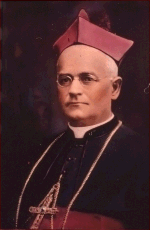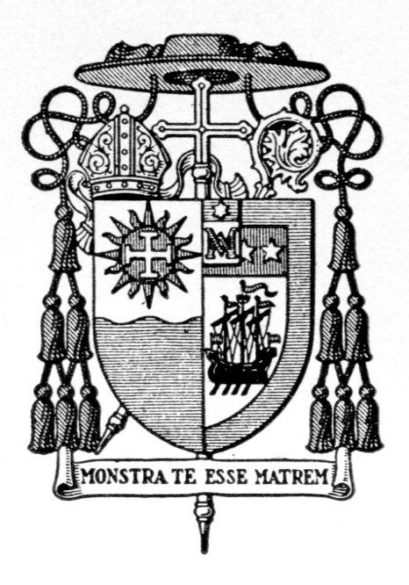From the Archives
By Mary Woodward
JACKSON – Since we focused on Bishop John Gunn’s surviving the arsenic attack in 1916, I thought I would share some more details about the bishop from the early pages of his diary.

Bishop Gunn was born on March 15, 1863, in County Tyrone, Ireland. He was the oldest of 11 children. His family originally came from Scotland to County Tyrone as descendants of Olaf the Black, a Viking ruler of the Isles off the coast of Scotland in the 13th century.
Hence, they called themselves the “Black Gunns of Caithness” and the family motto was aut pax aut bellum (either peace or war).
Bishop Gunn honors this heritage on his coat of arms with a Viking ship, but wisely chose not to use the family motto for his episcopal motto. He instead chose Monstra Te Esse Matrem (show thyself to be our mother) which comes from his formation as Marist priest.
He studied at the Gregorian University in Rome and was professed in 1884 and ordained a priest in 1890. He was ordained a bishop on August 29, 1911, at Sacred Heart Church in Atlanta where he had been serving for 13 years. Fellow Marist and Archbishop of New Orleans, James Hubert Herbert Blenk, was the principal consecrator.
In reading through the early entries of Bishop Gunn’s diary, it is evident that Archbishop Blenk was a great friend and mentor to him.

From Sept. 11, 1911, we read: “I went to Archbishop Blenk where the only misunderstanding I ever had with him was explained. I knew that I had been proposed for San Antonio and I made Archbishop Blenk promise he would oppose any and every effort to have me appointed a Bishop anywhere. When my appointment came, I accused him a breaking his promise and he showed me letters from Cardinal Gibbons which explained my appointment to Natchez and cleared Blenk. The Archbishop brought me to his friends in New Orleans and tried to give me the necessary courage to face Mississippi.”
His next entry from Sept. 14, supports the previous: “Started for Natchez with Father Larkin and my brother, Father Ed. I wanted Blenk to come – he refused, telling me that I was old enough to face the music without a chaperone and that the Natchez spotlight was not brilliant enough for two. I think his advice was correct.”
A few months later on March 21, 1912, Bishop Gunn gives us an interesting insight into his ministry as Bishop in describing a meeting of the Bishops of the Province of New Orleans. In 1912, the then Diocese of Natchez was part of the Province of New Orleans. Dioceses are structurally arranged according to provinces and then regions. Provinces center around an archdiocese and archbishop, known as the metropolitan.
Currently the Diocese of Jackson is part of the Province of Mobile that was established in 1980 when Mobile was elevated to an archdiocese. The dioceses of Jackson, Biloxi and Birmingham are suffragan sees under the archdiocese of Mobile. Coincidentally, our own Bishop, Joseph Kopacz, is the senior suffragan of the province led by Archbishop Thomas Rodi.
Back to 1912 where we were a suffragan see of New Orleans. Bishop Gunn describes the March 21 meeting in this manner: “That was my first introduction to the Bishops of the Province of New Orleans and a more congenial lovable lot of men I never met.
“I was born afraid of Bishops. I ran and hid from them when I could, feared them, and never met any of them that I thought worth knowing until I met the Bishops of the New Orleans Province. Such men as Gallagher of Galveston, Meerschaert of Oklahoma, Morris of Little Rock, Allen of Mobile and the younger crowd – Shaw of San Antonio and Lynch of Dallas, and of course, the greatest Roman of them all – the Archbishop of New Orleans [Blenk].”
“The meeting was a serious one and a useful one, but it did not prevent Meerschaert and Van de Ven from initiating Lynch and myself with some third degree work, especially suited to the Mutt and Jeff of the Bishops of the Province. I met most of these Bishops at my consecration, but I got to know them on the 21st and if knowing is akin to loving, I see my finish.”
Having served in the diocesan structure for more than 30 years, and in a particularly close way having served the office of bishop, I have observed a lot about the office and the men in it. I think often we forget that these are men, not statues, and they have very real fears and trepidations in accepting the office. Heavy is the head that wears the miter.
During this Advent, I am aiming some extra prayers for the bishops with whom I serve and have served. I encourage you to do the same. They need it.
(Mary Woodward is Chancellor and Archivist for the Diocese of Jackson)
